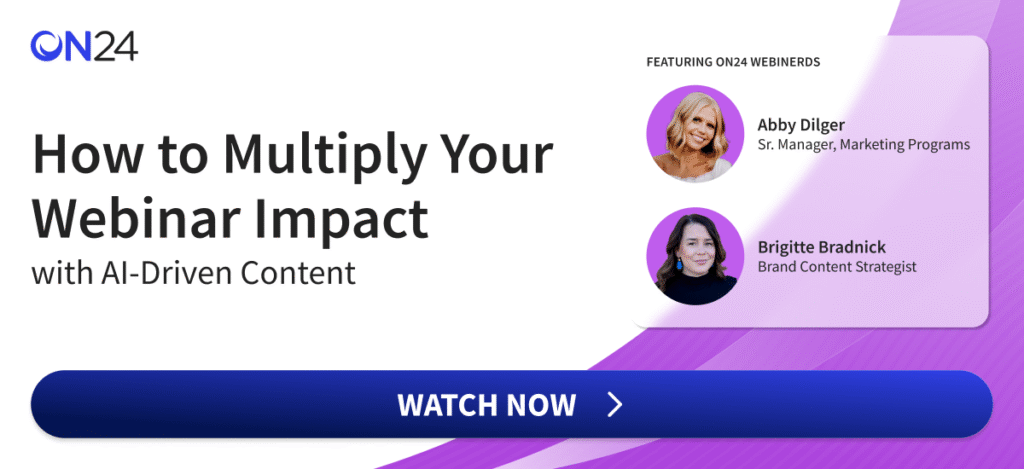Webinars are a great foundation for content repurposing. The tens of thousands of words spoken during a webinar act as a robust source of thoughtfully crafted, detailed, and well-formatted content. One webinar or virtual event alone can be turned into 10 or more versatile assets — blogs, e-books, social clips, podcasts, transcripts, nurture pages, and more — to drive full-funnel marketing impact and scale more efficiently. In this way, webinars provide a foundation for a ready-made campaign-in-a-box that drives outsized results.
As part of an effective content repurposing strategy, here are five steps to follow as you plan your webinar. This will ensure your webinar will unearth insights from your audience but also provide plenty of opportunities for derivative content.
Step 1: Define your “why”: set SMART campaign goals
At the heart of any effective marketing strategy is a SMART goal. By defining a goal for your webinar and the subsequent campaign that’s specific, measurable, actionable and time-bound, you can keep your planning focused and on track. Determine why you are running this event and how it ties into your overall strategy. Is it a lead generation campaign? Are you trying to accelerate pipeline? Or are you sharing thought leadership?
Without a defined goal, it’s easy to spend time and budget on a webinar and wider campaign that misses the mark. A clear goal keeps your team aligned, guides your content and audience choices, and makes it easier to measure success.
Tips for setting effective goals for a webinar-driven campaign
For a webinar that powers an entire campaign across formats and channels, look to break out of a tactical, webinar-only mindset into one that is more holistic. At the very least, make sure your strategy includes the use of on-demand webinars.
Here is a list of do’s and don’ts for setting the right types of goals.
| Do | Don’t |
| ✅ Set goals that are tied to pipeline and revenue | ❌ Set goals based only on views, registrations or attendance |
| ✅ Create goals by segment or key audience | ❌ Set the same generic goals for all audiences, ignoring segments or key differences |
| ✅ Establish both campaign-wide goals and channel specific goals | ❌ Rely only on a single, broad goal without considering goals for specific channels |
| ✅ Be specific if setting goals based on leads — for example, measure qualified leads, SQLs or net new contacts from target accounts | ❌ Use vague lead-based goals (e.g. total form fills) without defining what type of leads matter |
| ✅ Use analytics from past campaigns and webinars to establish realistic baselines | ❌ Ignore historical analytics and benchmarks when setting goals |
Step 2: Use first-party data to define your audience
Take advantage of the first-party data you already have, whether it be in your CRM, webinar platform, marketing automation platform or ABM tools. This first-party data will help you identify the most promising audiences or segments. It also helps your outreach across channels by giving you a foundation to specifically target the right audience through paid media, identify earned media channels where you can reach them and personalize the experiences they will see on your own channels wherever possible.
Third-party data also has value. As an example, services such as Dun & Bradstreet provide firmographic data that helps identify accounts to target, while ABM platforms such as 6sense, provide valuable intent data.
Step 3: Consider using first-party engagement data to reach your audience and personalize their experience
Today’s marketing relies on data. There are a few different types of data, each with its own strengths and weaknesses. First-party data gives you a better understanding of your audience by providing insights on their intent. It’s often the most reliable and accurate form of data and enables you to tailor and personalize content to reach your target audience.
Think about how you might use first-party data to better reach your target audience across paid, earned and owned channels — and how you can personalize their experience to maximize performance.
ON24 makes it easy to capture rich first-party data from your audience by tracking every interaction during your webinars and digital events. From registration details to poll responses, questions and content downloads, you get a full view of attendee behavior. These insights help you understand what prospects care about, score leads more effectively and follow up with personalized outreach.
Step 4: For any webinar, plan to cover at least three themes that can power standalone content
Few formats or channels allow for the same level of breadth and depth as a webinar. For example, a shorter video clip posted on social media may be more effective than embedding one that is an hour long — and in any case, it would be better to direct audiences to watch any past webinar within a dedicated platform that offers a richer experience and can collect more first-party engagement data.
Because such repurposed content will only feature a small part of your overall webinar, it makes sense to structure your webinar into clearly defined sections and themes. This has the following benefits:
- Relevant content covering a key theme will be grouped together. This makes it easier for video clips and key moments to be created, as they do not need to be individually selected and collated from throughout the session.
- AI-generated content on a given theme is likely to be higher quality. Clearly defined sections provide context to large language models, allowing for more effective and relevant content generation.
- Aside from content repurposing, a clear structure makes it easier for webinar viewers to understand the content and engage with the session. This will help you to more effectively achieve your goals.
As a guide, aim to have three to five themes in your webinar. This provides the foundation for several standalone content items, while ensuring your webinar covers each theme in sufficient detail.
Step 5: Align your goals, content and audience in your plan
Combining clear goals with audience insights helps you create webinars that truly connect — and which provide the basis for standalone, repurposed content for your entire campaign. Use your SMART goal to define success, and let first-party data guide your topic, format and content to match what your audience cares about.
Aligning your objectives with your audience’s needs makes your webinars — and the repurposed content that follows — more relevant and more effective at driving the actions that matter to your business.




